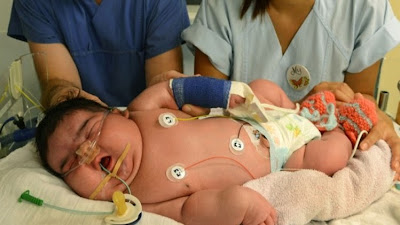 |
| Big Baby!!! It's impressive that baby Jasleen was delivered without a C-section — but was it safe? Since entering the world at 13.47 pounds last Friday, baby Jasleen has made headlines and records. Jasleen was delivered vaginally at University Hospital in Leipzig, making her the largest baby in the country to be delivered without a cesarean section. However, while people have been cooing over the giant bundle of joy and marveling that her mother, Maria, delivered her vaginally, is it safe for a baby to be that large and be delivered without a C-section? The answer, generally speaking, is no. But the circumstances in this case are complicated by the reason behind baby Jasleen’s girth: Her mother had been suffering from an undiagnosed case of gestational diabetes. Gestational diabetes is usually tested for between 24 and 28 weeks of pregnancy. It is very treatable, often with just monitoring the mother’s blood sugar and bringing in diet and exercise changes. In fact, insulin medicine is recommended for only 10 to 20 percent of women with gestational diabetes, according to the Mayo Clinic. When it is left untreated, though, the extra glucose in the mother’s bloodstream crosses the placenta to trigger the baby’s pancreas to make insulin. As a result, the baby grows to an unhealthily large size, a condition known as fetal macrosomia, which is somewhat arbitrarily defined at a threshold of 8 pounds, 13 ounces — a threshold that Jasleen well exceeds. Generally, babies with fetal macrosomia are delivered via C-section. Due to their large size, there is greater likelihood for shoulder dystocia, which is when a baby’s shoulder cannot fit through the mother’s pelvis and the baby gets caught in the birth canal. Dr. Elizabeth G. Baxley and Dr. Robert W. Gobbo at the American Academy of Family Physicians (AAFP) call it "one of the most frightening emergencies in the delivery room," in part because a trapped baby may not be able to breath. Yet, despite the evidence in favor of a C-section, the doctors at University Hospital were not necessarily wrong in their decision to naturally deliver Jasleen. According to a hospital statement by chief of obstetrics Holger Stepan, "We decided to try natural birth, as a child of this size [with] the excess weight of the mother, a cesarean section would have been associated with a significant risk." Though fairly routine, "C-sections can be risky for both the baby and the mother," notes James Fleur at Science Recorder. Possible problems include blood clots for the mother and breathing problems for the baby. Moreover, since Jasleen’s mother had never been previously treated at the hospital, the physicians were unaware of her gestational diabetes and likely could not anticipate how large a baby Jasleen would be. And it’s not unheard of to vaginally deliver a baby of that size. Just this March, British baby George King was delivered vaginally, clocking in at 15 pounds 7 ounces. However, it was a very close call with baby George; he did get stuck in the birth canal and suffered oxygen loss, reducing his surivival rate to 10 percent. And unfortunately, there may be health issues in Jasleen’s future. According to the American Diabetes Association, babies born to mothers with untreated gestational diabetes are also at a higher risk for obesity in childhood and type 2 diabetes in adulthood. At the moment, though, baby Jasleen is doing well and being cared for in the hospital’s neonatal unit. Her mother is also doing quite well, though still recovering from the shock of her big surpise. She told the Daily Mail, "I had no idea there was such a giant inside of me." |
konga
Friday 2 August 2013
BIG BABY!!!!
Subscribe to:
Post Comments (Atom)
No comments:
Post a Comment